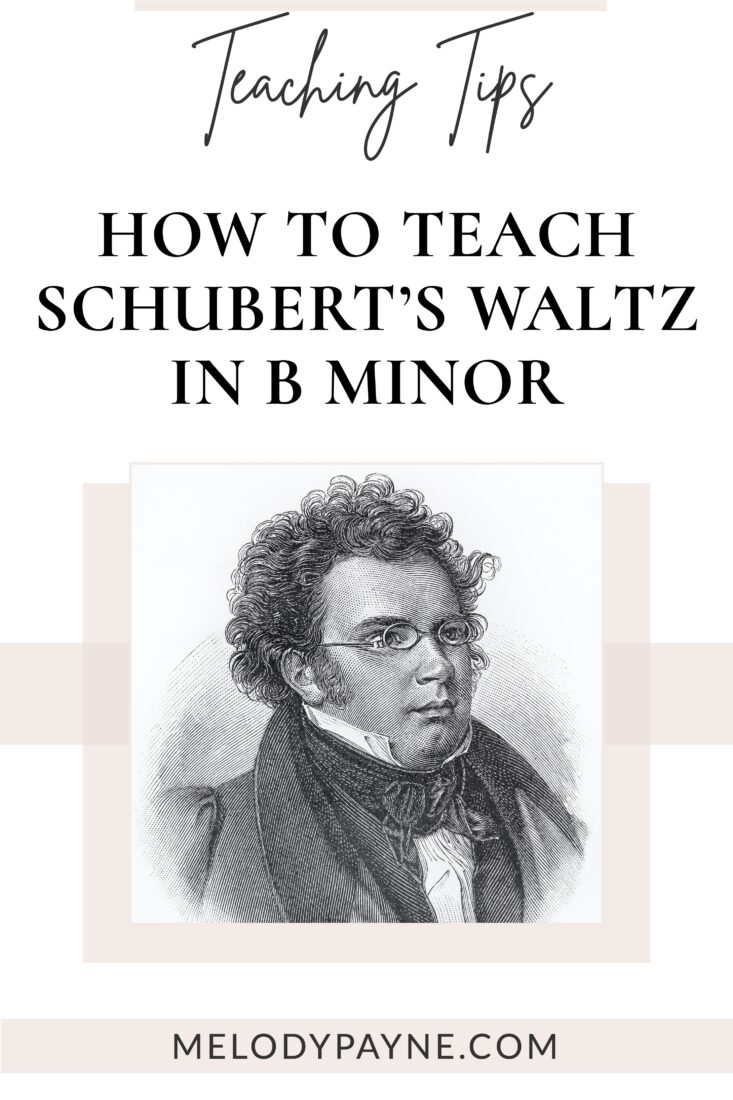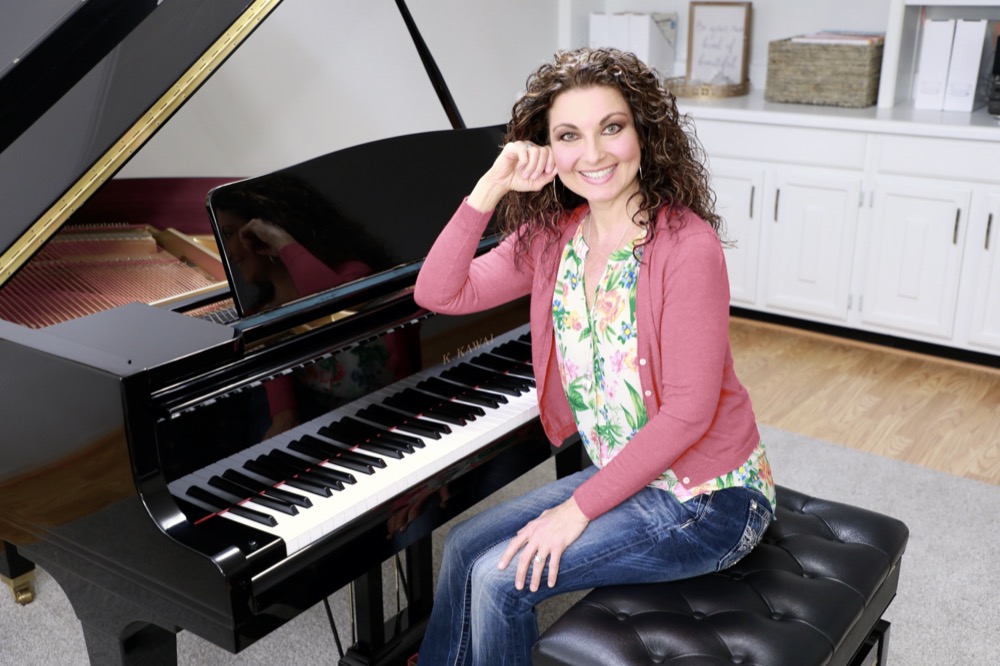A Deep Dive into Schubert’s Waltz in B Minor
This post may contain affiliate links. If you purchase something through an affiliate link, I will receive a small commission at no cost to you. For more information, read the disclosure statement here.
If you are thinking about teaching Schubert’s Waltz in B Minor but are a little unsure, let me introduce the author of this guest post, Janna Williamson. Janna is a pianist, educator, and collaborator who loves teaching intermediate piano repertoire in ways that helps students achieve deeper levels of musicality and artistry. In this article, Janna demonstrates how she would introduce and teach Schubert’s Waltz in B Minor to an intermediate student. Please enjoy Janna’s article and teaching video as we take a deep dive into Schubert’s Waltz in B Minor.

A Deep Dive into Schubert’s Waltz in B minor
Teachers – what is your superpower? My piano teacher superpower seems to be teaching intermediate historical repertoire in a way that allows my students to play expressively. I love getting my students engaged with works by the great masters, including one of my all-time favorites, Franz Schubert, whose Waltz in B minor, D.145 / Op.18, No.6 I will discuss here.
Technical Considerations for Schubert’s Waltz in B minor
When approaching any piece of intermediate historical repertoire, my first question is very practical: what technical features will be difficult for my student? It is my job to prepare him for what he will encounter.
If this piece includes extensions of skills he has already developed, then that is an easy lesson conversation. But if there is an entirely new skill, our first lesson should include a discussion of that, and I should particularly assign practice techniques that develop that skill.
Musical Characteristics of Schubert’s Waltz in B minor
My second, and more interesting question is: what are the key musical characteristics of this piece? What makes it unique? What would an audience member remember about it after hearing it once? And is there historical context from the time period or biographical information about the composer that informs what I think is the main idea of the individual piece? I want to be sure my students are clear on this so that they can play expressively and allow their listeners to hear those key features.
It should go without saying that the other reason to identify the unique characteristics of any given piece is to foster emotional connection between my student and the piece at hand. While I might love Schubert’s music and immediately connect with most of his pieces, my student may be encountering him for the first time and have no reason to emotionally engage unless I foster that attachment.
Historical Considerations for Schubert’s Waltz in B minor
Schubert is a composer who is often difficult to understand because we have very little biographical information available. He didn’t write in a diary like Robert Schumann, and unlike Wolfgang Amadeus Mozart, if he wrote many letters, they didn’t survive the past 200 years. He left many compositions unfinished or unpublished during his short life.
Although he was known during his lifetime primarily as a composer of “domestic” music – songs and dances that could be performed by amateurs at home, he also wrote many large-scale instrumental works, including piano sonatas, symphonies, and string quartets.
I firmly believe that his songs (Lieder) are, in fact, his greatest legacy and gift to the canon of classical music. Anyone playing piano pieces by Schubert should know that he wrote over 600 songs. This informs even the least experienced player that the melody will be important, even in solo piano music. The melody should be phrased beautifully and balanced well over the accompaniment.
Waltz Bass Preparation in Schubert’s Waltz in B minor
Another key feature of this piece is that it is a waltz. Therefore, it is in 3/4 time, with a waltz bass in the left hand. (Oom-pah-pah!) In this particular waltz, the waltz bass is not in a closed triad position, but involves a jump from the bass to an inverted chord.
It’s likely that this piece is the first time my student has encountered a jump bass, so I will need to assign practice techniques to help him play it well and without much distress. We will also need to discuss pedal options and balance of the melody over the quickly moving accompaniment.
The Importance of Major and Minor
Last, but certainly not least, is the fact that this piece, while in B minor, switches to the parallel key of B major at the end. This is the magical moment of the piece, and one that can spark the imaginations of our students.
While many composers use the relative key relationship, switching from parallel minor to major or vice versa is a Schubert trademark, and one that can easily be found in many of his works of any genre.
Because Schubert’s music is so meaningful to so many musicians, and yet we do not have much evidence of what the composer was thinking about when he wrote it, musicologists and theorists have long pondered what he might have had in mind.
Schubert wrote so much music with text, primarily early Romantic poetry set to music in his songs. Therefore, theorists have argued that looking at how he set that text can inform our understanding of his music without words.
One trend that starts to appear is Schubert’s use of the major and minor modes. It seems that Schubert often sets texts about things outside of this world – for example, heaven, mythological characters, or an imagined future – in a major key. Conversely, he sets anything in the character’s reality, or anything in the “here and now,” in a minor key.
One classic example of this is Schubert’s famous song Erlkönig, set to the dark fairy tale poem by Johann Wolfgang von Goethe. The poem contains four characters: the narrator, the father, the boy, and the Erlking, a mythological elf king. The Erlking, the only unreal or imagined character, is the only one whose lines are sung in a major mode.
Here’s a wonderful performance of Schubert’s Erlkönig.
Theoretical Considerations in Schubert’s Waltz in B minor
So what does this theoretical / musicological argument have to do with our intermediate students? Well, this is our chance to stimulate our students’ imaginations. What happens when that first B major chord appears? Were we suddenly transported to a heavenly landscape? Did a character from a fantasy land suddenly appear? Did the protagonist pass from this world to the next?
Most students don’t need much prodding to come up with an idea of how the story moves from real to unreal. One of my students related it to Cinderella – the minor part was poor Cinderella completing her thankless chores, and the major part was her fairy godmother appearing.
The options are endless, and there is no right or wrong answer. The goal is simply to draw out our student’s understanding of what is happening musically and help them perform expressively in a way that highlights that feature.
This type of activity also teaches our students to actively listen to classical music. Our pre-college students are the musical patrons of the future! While I do use current music in my teaching and give students a large amount of choice in what music they want to play, I also take great joy in knowing that I have given them tools to actively listen to music from the past.
Since writing out technical suggestions in text is difficult, I’m linking a video here where I go over some of these ideas and more. I hope you have enjoyed this deep dive into one of my favorite teaching pieces!

If you liked learning how to teach Schubert’s Waltz in B Minor…
You’ll also love Janna’s post, A Deep Dive Into Sonatina In F Major By Beethoven.
Other helpful posts about teaching music to students
Don't miss out!
Follow on Facebook and Instagram, join the best Facebook group for piano teachers, and subscribe to the newsletter to get helpful teaching tips, resources, and tutorials delivered straight to your inbox every week.
Janna Williamson
Janna Williamson
Welcome!

Hi! I’m Melody Payne, a pianist and piano teacher, educational resource author, a fun-loving wife to the most wonderful and talented hubby I could ask for, and a lifelong learner who loves to share. I want to make your life as a music teacher easier by writing and sharing helpful and relevant music teaching articles, and by creating educational resources with your very own students in mind. If you are a parent who wants to enroll your child in piano lessons, I’d love for us to get started building those skills that can give your child a lifetime of musical enjoyment!



